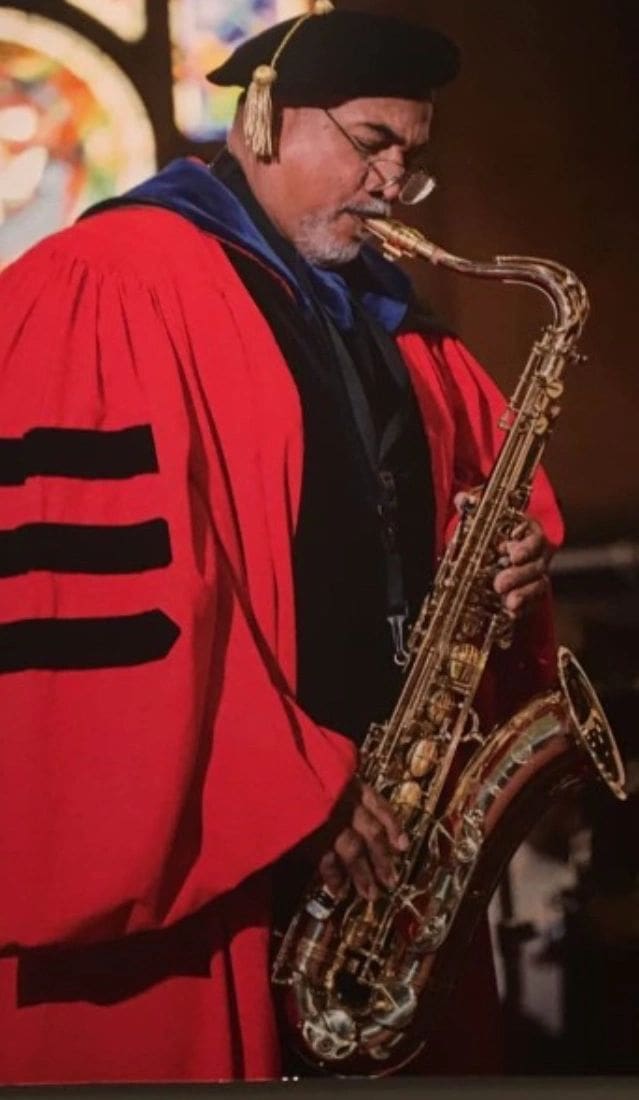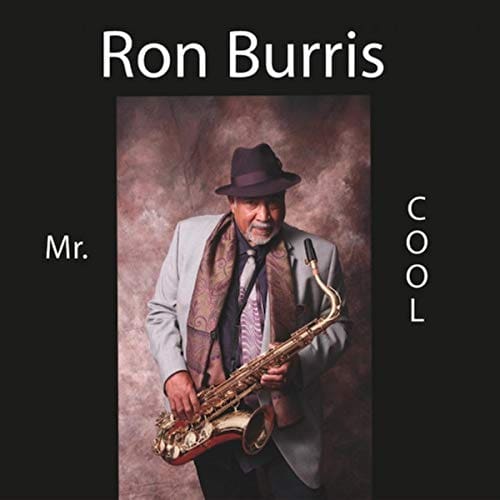
Reviews
Ron Burris Jazz...Never Felt So Good. This is Ron Burris’ third CD as an independent artist, and, as the title implies—he has never felt better. Ron has selected some excellent musicians to assist him in bringing out the different qualities of these eight standards and one original song on this CD. To get things started, Ron and the guys offer a fresh rendition of Coltrane’s Impressions. The entire group plays with passion to the very last note. Additionally, Kendrick Freeman, drum solo and drumming throughout adds to the beauty of this selection. Next up, is the beautiful Brazilian song, Black Orpheus. On this piece Leo Cavangh is outstanding. He sets the stage with a beautiful intro and outro, after which Ron and John (piano) do an excellent job in keeping the mood of the song nice and mellow. One can easily get up and dance upon hearing this lovely song. The next song, Yes & No by Wayne Shorter is the longest song on the CD. Respecting the great legacy that Mr. Shorter has left music, we dedicated our performances in memory of this great man. In doing so, we allowed ourselves time to say thank you to this great artist. It felt so good playing and hearing Dave Macnab (guitar) and John Simon (piano) stretch out on this piece. I think Mr. Wayne Shorter would have been proud of our efforts. Returning to the bossa nova -feel, our fourth song, is the popular standard, Blue Bossa, by Kenny Dorham. Like, Black Orpheus, one can easily get up and dance upon hearing the nice grove the guys set here. Certainly, one must move their feet to the beautiful rhythms of Kendrick on Drums and Stephen on Bass. Never Felt So Good, the title of the CD, is a simple tune, that is meant to express the wonderful feeling I have for this song and the entire CD. It is meant to be simple, but expressive. At the end of the piece, John and I exchange simple phrases that match the title of the song- and at the very end, I can be heard stating, “It Never Felt So Good. The beauty of music in our livies, allow us to be thankful for what we do have, and rejoice. Life is not perfect, but music makes it feel so much better. From here, we pick up the tempo again, with John Coltrane’s classic tune, Moment’s Notice. This is a challenging, yet beautiful piece by Coltrane. Again, it felt good playing, and hearing Dave and John interpret this master piece. Taking on the challenge, and hearing the results, makes me proud of our efforts. To change the pace again, we play Sugar by Stanley Turrentine. When Stanley wrote Sugar, he wrote a beautiful melody accompanied by some equally beautiful chords. Taken together they offer a beautiful song, that one never gets tired of hearing. We did our best to play it, with the soulful, funky, and sweetness the master intended
Ron Burris Never Felt So Good An excellent straight ahead tenor and alto saxophonist who is based in Northern California, Ron Burris long had his own personal sound on his horns. While he started off playing r&b with Project Soul (a band that was later successful as Con-Funk-Shun), Burris has long since switched to jazz. He had success with his first CDs, Mr. Cool and Shades Of Jazz, and that continues with his latest, Never Felt So Good. For this set, Ron Burris performs eight standards and one original with the nucleus of the group that he utilized on Shades Of Jazz. He is joined by guitarist Lee Cavanaugh (Dave McNab takes his place on three numbers), pianist John Simon, bassist Stephen Webber, and Kendrick Freeman on drums and congas. To his credit, Burris does not sound like anyone else, even on songs closely associated with John Coltrane, Wayne Shorter and Stanley Turrentine. The program begins with a driving version of Coltrane’s “ Impressions.” The tenor’s passionate solo is followed by rewarding statements from Simon and McNab and a brief spot for drummer Freeman. The bossa-nova classic “Black Orpheus” is notable for the countermelodies that Burris creates. Shorter’s Yes Or No, which was performed in tribute to the late innovator, has some particularly fluent tenor and one of pianist Simon’s best solos of the set. “Blue Bossa,” the best known of Kenny Dorham’s compositions, is given a very likable treatment and, as is true on most of these performances, has rewarding tenor, guitar and piano solos. Burris’ “Never Felt So Good” is a joyful swinger that fits its title. The rapid tempo of Coltrane’s “Moment’s Notice” not only is no problem for the tenor but Burris gives one the impression during his inventive solo that he could have endlessly come up with creative ideas on this song. Never Felt So Good concludes with a rollicking version of Turrentine’s “Sugar,” an excellent solo by Burris on alto for “Ornithology,” and the leader’s heartfelt statement on “Everything Happens To Me." The playing throughout Ron Burris’ album is top-notch and enjoyable, showing listeners that there is plenty of life to be found in straight ahead jazz today when played by musicians of this high caliber.
Scott Yanow, jazz journalist/historian


Ron Burris is a talented saxophonist who is based in Vallejo, California. His early background was in r&b including performing with Project Soul, a group that later had success as Con-Funk-Shun. After becoming inspired by Gene Ammons, he switched his focus to jazz. A few years ago Burris released his debut CD, Mr. Cool, and it has now been followed by Shades Of Jazz.
For his set of six standards, a superior obscurity and four originals, Ron Burris is joined by guitarist Leo Cavanagh, pianist John Simon, bassist Stephen Webber, drummer George Smeltz, and percussionist Ron Carson. Throughout the program, which has plenty of variety, Burris shows that he is equally skilled on tenor, alto and soprano saxophones. He begins on tenor, swinging hard on John Coltrane’s “Giant Steps.” Here, as on most of the songs, Cavanagh and Simon also make strong statements while Webber, Smeltz and Carson provide stimulating support. Next is some excellent no-nonsense bebop playing on Kenny Burrell’s “Lyresto” (a fine song that is not performed that often) and an uptempo “Yardbird Suite” that really cooks and features Burris on alto. Bassist Webber displays both courage and creative fluency by soloing on the latter.
The mood changes a bit on the saxophonist’s “Cruizzin With The Top Down,” a piece with a relaxed melody and effective laidback solos. “Let The Children Dance” is a happy party number with a calypso feel and a spirited vocal by Laurice McCoy Ozyuwah. It is followed by “Clouds,” superior easy-listening music with Burris on alto that has an upbeat melody with a bossa nova beat.
Freddie Hubbard’s classic jazz waltz “Up Jumped Spring” is warmly embraced by Burris on soprano-sax and receives one of its most rewarding treatments in years. After he is featured on a warm version of “My One And Only Love,” Burris performs his catchy Tranish song “Mr. J.C.” It sounds like a piece that John Coltrane would have enjoyed stretching out on. The enjoyable CD concludes with a beautiful and picturesque version of the leader’s “Sunset.”
Listening to Shades Of Jazz, it is not surprising to realize that it was on JazzWeek’s top 50 jazz chart for eight weeks. From bop to bossa, John Coltrane to Freddie Hubbard, it succeeds on every level and features Ron Burris and his musicians in top form. Shades Of Jazz, which is available from www.ronaldburrisjazz.com, is highly recommended to anyone who enjoys melodic modern jazz.
Scott Yanow, jazz journalist/historian
Mr. Cool
This is probably the first time in quite a long while that I find a perfect match between an album title and its content. “Cool” is definitely the word that I would use to describe Ron Burris and his music. He has an incredible control over the dynamics of his compositions, and everything he does is completely spot-on, perfectly expressing his emotion and energy through the music.
This amazing album features nine songs, and it’s great to experience how each track explores a different texture and creative idea, highlighting Burris’ incredible versatility as a jazz performer. The first song, “Mode for Hank,” blinks an eye to the classic edge of the genre, with a truly smooth approach to saxophone and quite a fantastic feel to it. What’s even more interesting is the fact that Burris has the ability to play complex and articulate lines, yet he knows when to go for a more understated sound, keeping the music first and creating some truly engaging soundscapes for his audience. After all, great music is not just about showing off. Some jazz performers feel like they’re trying to sprint and outpace the others, and as a result, they are quickly found gasping for a breath of air. This is never the case for his playing. He flows and travels smoothly, never overdoing it and always staying true to the songs.
Tracks like the title song itself as well as “Blues for Carla” and the final song, “You Send Me,” are actually really great example of what I am talking about it. If you like modern jazz records with a warm and classy vibe, this one should be right up your alley indeed. Straight out of California, Burris could rightfully be described as a jazz veteran, and as a saxophone player, he constantly strives to come up with new, exciting ideas and ways to express himself, even through he is as accomplished as it gets musically! The artist’s constant pursuit of great sound is truly inspiring.
